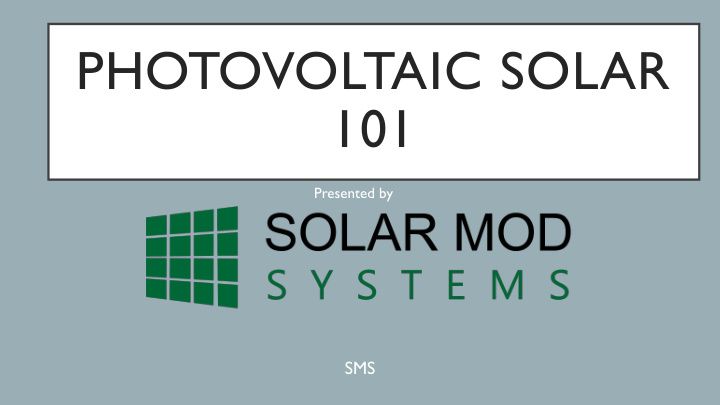



PHOTOVOLTAIC SOLAR 101 Presented by SMS
Let’s start with the basics… These are the symbols for AC and DC current, you will see a variation of at least one of these symbols on most electronic devices depending on which voltage they use. AC DC
= x Power Voltage Current Volts Amps Watts
VOLTAGE • Voltage is the electromotive force, or potential difference expressed in volts. However, it’s easier to think of it as an electric “pressure” that pushes current through the wire. • Common voltages in solar power systems are 12v, 24v, and 48v.
CURRENT • Current is the flow of electrical charge in a circuit measured in the flow of electrons per second. • In a DC system it is very important to know how much current is going through your wires, as it determines what gauge of wire you can use.
POWER • Power is the measure of how much energy your solar system is producing or consuming. • It is measured in watts and is calculated by multiplying your voltage and current together.
SAFETY • The higher the voltage, the easier it is to be shocked. • Always be careful with metal tools, even in a low voltage environment. • DC voltage can ‘grab’ you. • Do not touch someone getting shocked with your bare hands!
BASIC PV SOLAR SETUPS Panels Charge Controller Batteries Inverter Load
HOW PHOTOVOLTAIC WORKS PV panels generate electricity from sunlight through the use of silicon crystals. The crystals are used to form solar cells, each cell generates around half of a volt, but are run in series to form entire solar panels. PV panels can have a wide range of voltages, anywhere from 6v to 48v.
CHARGE CONTROLLERS • Your charge controller is the next step in line after the panels generate the power, it controls how much power is put into your batteries to prevent overcharging. • Most charge controllers are MPPT, or Maximum Power Point Tracking. Allowing you to harvest solar energy even if your solar panel voltage is lower than the battery voltage. • On top of charging batteries, they also act as a safety override in case your batteries get overheated, or a short is detected.
BATTERIES • In solar applications, lead acid batteries are the most common as they are safe, easy to use, and relatively affordable when compared to lithium batteries. • Solar Mod Systems uses AGM batteries (Absorbent Glass Matt) because unlike traditional flooded lead acid batteries, the user does not have to periodically add water to them. Making them ideal for low maintenance off-grid solutions. • Lithium based batteries are more efficient and lighter but are less heat tolerant and more volatile if there is a thermal runaway.
INVERTER • The inverter is what converts your batteries DC current into AC current. • Besides voltage and current, AC power also has the variable of frequency, measured in hertz (hz). Frequency is the number of times that current changes direction per second in an AC circuit. • There are several different power standards in the world, the most popular being 110v/60hz and 220v/50hz.
LOAD • The load is what your solar system is currently powering. • It is very important to know what your net production and consumption is going to be. Even a 300w solar array can power a 2kW device as long is its only on for short periods of time. On the other hand, a 1200w array can’t power an 800w system that is on for 24 hours a day, as power is only generated during sunlight hours.
THANK YOU
Recommend
More recommend